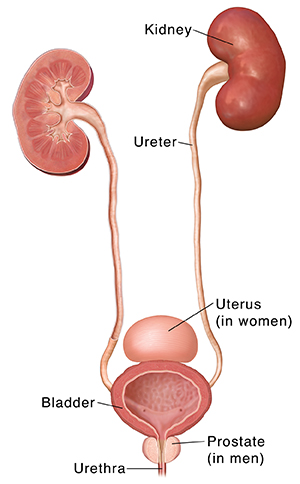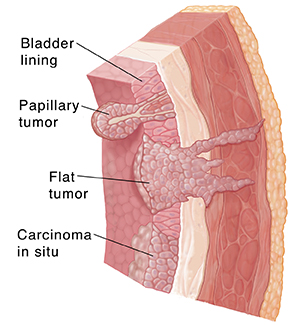Understanding Bladder Cancer
Understanding Bladder Cancer

The urinary system includes the kidneys, ureters, bladder, and urethra. This body system makes, stores, and gets rid of liquid waste called urine. The two kidneys filter blood to collect waste and make urine. The ureters are small tubes that carry urine from each kidney to the bladder. The bladder is where urine is stored before it leaves the body. The urethra is the tube urine goes through to leave the body.
Bladder cancer means that certain cells in the bladder have changed in ways that aren't normal.
When bladder cancer forms
Cancer is a disease that causes cells to change and multiply out of control. The multiplying cells may form a lump of tissue (tumor). With time, the cancer cells destroy healthy tissue. They may spread to other parts of the body. Why some cells become cancer is not always clear. But bladder cancer is strongly linked to cigarette smoking. The longer a person smokes and the more a person smokes, the greater that person’s chances of developing bladder cancer.
Types of cancer that may form
Most bladder cancers are urothelial carcinomas, also called transitional cell carcinomas. They start in the cells that line the inside of the bladder. Bladder cancer may grow in different ways:
-
Papillary tumors stick out from the bladder lining on a stalk. They tend to grow toward the bladder cavity, away from the bladder wall, instead of deeper into the layers of the bladder wall.
-
Flat tumors do not stick out from the bladder lining. These tumors are more likely than papillary tumors to grow deeper into the layers of the bladder wall.
-
Carcinoma in situ (CIS) is a cancerous patch of flat tumor cells that is only in the inner layer of the bladder lining and has not spread to deeper tissue. The patch may look almost normal or may look inflamed.

Each type of tumor can be present in one or more areas of the bladder, and more than one type can be present at the same time.
Updated:
October 11, 2019
Reviewed By:
LoCicero, Richard, MD,Stump-Sutliff, Kim, RN, MSN, AOCNS